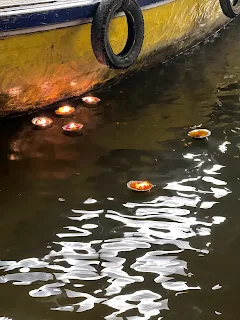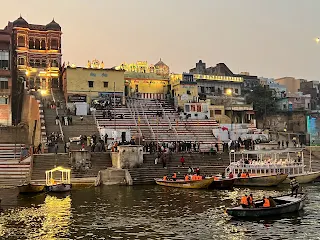Kashi, also known as Banaras or Varanasi, has been one of the ultimate pilgrimage spots for Hindus for ages. Hindus believe that those graced to die on the land of Varanasi attain salvation and freedom from the cycle of birth and rebirth.
Mark Twain once said, “India is the cradle of the human race, the birthplace of human speech, the mother of history, the grandmother of legend, and the great-grandmother of tradition.” He described Kashi as looking “older than history, older than tradition, older even than legend, and looks twice as old as all of them put together."
While many mythological stories abound, one states that the mighty Ganges, after passing through Shiva’s tresses, expands into the city of Varanasi. Anyone who bathes in the waters of the Ganges in Kashi washes away their mortal sins.
In January 2023, while visiting India, I found myself drawn to Varanasi. Accompanied by my parents, uncle, and aunts, we took an overnight train from Delhi to Varanasi. Arriving in the early hours of the morning, the city was covered in deep fog that felt like an omnious shroud. It felt as though you’ve crossed the threshold into another world—a world where time pauses, and the air thrums with an ancient energy.
Up until my visit, I had always thought that Varanasi was a place to perform the last rites of loved ones. But as I spent time there, I found that it is a city of the living and the dead, perhaps a city of contradictions.
Life Along the Ghats: A Non-Stop Show
Walking along the ghats felt like being in the middle of a street performance. Pilgrims bathed in the Ganges with devotion. The distinct smell of tanneries near the ghats filled the air. Vendors hawked flowers, beads, fruits, candles, and chai with equal persistence. Sadhus, wrapped in bright orange robes, meditated undisturbed by the occasional cow, dog, or monkey stealing a snack. The last rites and cremations being performed right by the water’s edge in the traditional ways.
The 84 Ghats
The ghats of Varanasi are more than alleys and steps leading to the river—they are the heartbeat of this ancient city. Each ghat carries a story, a purpose, and an energy of its own. It seemed as if each ghat had its own story, its own rhythm.
Dashashwamedh Ghat: The Ganga Aarti here feels like a celestial dance performed to honor the river goddess. As priests raised lamps of fire and chants filled the air, I couldn’t help but feel mesmerized and overcome with spiritualness.
Manikarnika Ghat: Watching the cremation rituals at this ghat was humbling. It reminded me of the transient nature of life. In Hindu belief, the Ganga is considered the holiest of all rivers and is revered as a goddess. Immersing the ashes of the deceased in her waters is thought to purify the soul and aid in its journey toward moksha from the cycle of rebirth.
However, when immersing ashes in the Ganges isn’t possible due to distance, logistics, or other reasons, any natural body of water can serve as a substitute. This is because all water is seen as a purifier and a connection to the divine. The underlying belief is that water, in its essence, has the power to cleanse and carry the soul to a higher state of existence, whether it’s a river, lake, or ocean.
Assi Ghat: At dawn, the Subah-e-Banaras program infuses the morning aarti with music, yoga, and the soft glow of the rising sun —a celebration of life’s renewal.
Note: We stayed at a hotel by Assisi ghat right by the water.
The Ganges: A Living Divine Presence
The Ganges is not just a river—it is life itself for those who live in Varanasi. Pilgrims flock to its waters with a faith that a single dip will cleanse their soul of sins accumulated over lifetimes. Watching the devotion with which people dip in the river (however polluted), I felt a ripple of spiritualism washing over me.
Even the simple act of sitting by the river, with the sound of water splashing the ghat stone, became a moment of meditation. The Ganges seemed to whisper age-old stories, a reminder of the generations that passed its shores.
A Boat Ride: Floating through Time
At dusk, we boarded a small wooden boat for a ride along the Ganges. The boatman, with his deep, melodic voice, sang devotional songs that echoed across the water, transforming the ride into an ethereal experience. His singing, blending with the distant chime of the temple bells and the hum of prayers from the ghats. Each song felt like a prayer to the divine, narrating tales of devotion, love, and spiritual yearning. The combination of music, the rhythmic drone of the motor boat, the golden glow of lamps from the ghats and the smoke from the cremation grounds created a moment of serenity— and spirituality that can only be felt and not expressed.
The Ganga Aarti: A show in itself
The Ganga Aarti is one of the most enchanting spiritual ceremonies, performed daily at the ghats of Ganga. A symbolic ritual that honors the Ganges River, revered as a goddess and lifeline in Hinduism. Held at several major ghats, the aarti is a mesmerizing confluence of light, sound, and intricate movements that captivates both the pilgrims and the tourists.
Performed in the early hours of dawn and as the twilight descends, priests dressed in traditional saffron robes take their places on elevated platforms. The ritual begins with the resonant chimes of temple bells, the rhythmic beat of drums, the synchronized movements and the collective chanting of Sanskrit mantras. The priests hold large, ornate brass lamps filled with burning camphor and perform intricate, synchronized movements, offering the flame to the river goddess as an act of reverence and gratitude.
The aarti is more than a visual spectacle; it is an immersive revered experience. The air rich with the fragrance of incense and flowers, mingling with the sounds of conch shells and devotional hymns. Diyas (oil lamps) are floated on the river, creating a shimmering pathway of light on the water, symbolizing prayers and wishes sent to the divine. The sight of the glowing lamps drifting downstream, mirrored by the calm waters of the Ganges, evokes a sense of tranquility and connection with the universe. Whether you are a spiritual seeker or simply a tourist, witnessing the Ganga Aarti is an unforgettable experience that leaves a profound imprint.
The Labyrinth of the Old City
Wandering through the narrow alleys of Varanasi’s old city was an adventure in itself. The lanes twisted and turned unpredictably, revealing hidden temples, bustling markets, and cows lounging nonchalantly in the middle of the path. Whether shopping for Banarsi sarees, or the Banarsi paan, or eating kachori and subzi, the traditions and legends of the old city are unescapable.
The Spirituality of Everyday Life
In Varanasi, spirituality isn’t confined to temples or rituals—it’s woven into the fabric of daily life. Sadhus sit in contemplation along the ghats. Families light diyas (tiny lamps) and release them into the river, their prayers floating on the water. The chiming of temple bells, the hum of the prayers, and the aroma of incense blended with the sights and sounds of life’s routine activities. It was as if every moment, no matter how small, was imbued with some divine purpose.
A Final Farewell
On my last evening in Varanasi, I returned to the Ghat for one final aarti. This time, I lit a small diya, placed it in the water, and watched as it floated away, joining many others. It was a simple act, yet it felt profound—a silent prayer to wash all mortal sins, a moment of gratitude, a celebration of life, a wish carried by the eternal waters of Ganges.
As I left the city, I realized that Kashi doesn’t just linger in your memory; it calls you and etches itself into your soul. It’s not a tourist destination but an experience—one that stays with you, urging you to return, to accept life and death.











